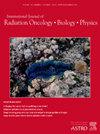Clinical Effectiveness of Single Course Low-Dose Radiation Therapy in Knee Osteoarthritis: Short-term Results from the Randomized, Sham-Controlled Trial
IF 6.5
1区 医学
Q1 ONCOLOGY
International Journal of Radiation Oncology Biology Physics
Pub Date : 2025-10-14
DOI:10.1016/j.ijrobp.2025.08.030
引用次数: 0
Abstract
Purpose/Objective(s)
Low-dose radiation therapy (LDRT) has been historically used as a non-pharmacologic option for osteoarthritis (OA), but solid evidence from randomized trials is still limited.
Materials/Methods
In this multicenter, randomized, sham-controlled trial, 114 patients with knee OA were allocated to receive sham irradiation, total 0.3 Gy/6 fractions, or total 3 Gy/6 fractions. The main inclusion criteria are primary knee OA classified as Kellgren-Lawrence grade 2–3 and a baseline walking pain score of 50–90/100. Use of concomitant analgesics, except for rescue drug, was restricted during the first 4 months. Re-irradiation was not allowed. The primary endpoint was the OMERACT-OARSI response rate at 4 months.
Results
All participants completed the treatment with perfect adherence. In the full analysis set, the responder rate at 4 months was significantly higher in the 3 Gy group (70.3%) than in the sham group (41.7%, p=0.014), whereas the 0.3 Gy group showed no significant difference compared to sham (58.3%, p=0.157). Similar results were observed in the per-protocol set. Clinically meaningful improvement (≥16) in WOMAC total score at 4 months was observed more frequently in the 3 Gy group (56.8%) compared to sham (30.6%, p=0.024). However, there were no significant differences in the mean changes from baseline in other secondary outcomes, including VAS, PGA, serum inflammatory markers, and the amount of rescue drug use. No treatment-related toxicity was reported.
Conclusion
A single course of 3 Gy LDRT led to significant improvement in clinical outcomes for patients with mild-to-moderate knee OA. These findings support its potential as a conservative treatment option. Long-term and imaging-based follow-up is ongoing.
单疗程低剂量放射治疗膝骨关节炎的临床疗效:随机、假对照试验的短期结果
低剂量放射治疗(LDRT)历来被用作骨关节炎(OA)的非药物治疗选择,但随机试验的可靠证据仍然有限。材料/方法在这项多中心、随机、假对照试验中,114例膝关节OA患者被分配接受假放疗,总剂量为0.3 Gy/6,总剂量为3gy /6。主要纳入标准为Kellgren-Lawrence分级为2-3级的原发性膝关节OA,基线步行疼痛评分为50-90/100。除抢救药物外,前4个月限制使用伴随镇痛药。不允许再照射。主要终点是4个月时的OMERACT-OARSI缓解率。结果所有患者均完成了治疗,并且完全依从性良好。在整个分析集中,4个月时,3 Gy组的应答率(70.3%)显著高于假手术组(41.7%,p=0.014),而0.3 Gy组与假手术组相比无显著差异(58.3%,p=0.157)。在每个协议集中观察到类似的结果。3 Gy组4个月WOMAC总分有临床意义改善(≥16)的频率(56.8%)高于假手术组(30.6%,p=0.024)。然而,其他次要指标,包括VAS、PGA、血清炎症标志物和抢救用药量,与基线相比,平均变化无显著差异。未见治疗相关毒性的报道。结论单疗程3 Gy LDRT可显著改善轻中度膝关节炎患者的临床预后。这些发现支持其作为保守治疗选择的潜力。正在进行长期影像学随访。
本文章由计算机程序翻译,如有差异,请以英文原文为准。
求助全文
约1分钟内获得全文
求助全文
来源期刊
CiteScore
11.00
自引率
7.10%
发文量
2538
审稿时长
6.6 weeks
期刊介绍:
International Journal of Radiation Oncology • Biology • Physics (IJROBP), known in the field as the Red Journal, publishes original laboratory and clinical investigations related to radiation oncology, radiation biology, medical physics, and both education and health policy as it relates to the field.
This journal has a particular interest in original contributions of the following types: prospective clinical trials, outcomes research, and large database interrogation. In addition, it seeks reports of high-impact innovations in single or combined modality treatment, tumor sensitization, normal tissue protection (including both precision avoidance and pharmacologic means), brachytherapy, particle irradiation, and cancer imaging. Technical advances related to dosimetry and conformal radiation treatment planning are of interest, as are basic science studies investigating tumor physiology and the molecular biology underlying cancer and normal tissue radiation response.

 求助内容:
求助内容: 应助结果提醒方式:
应助结果提醒方式:


